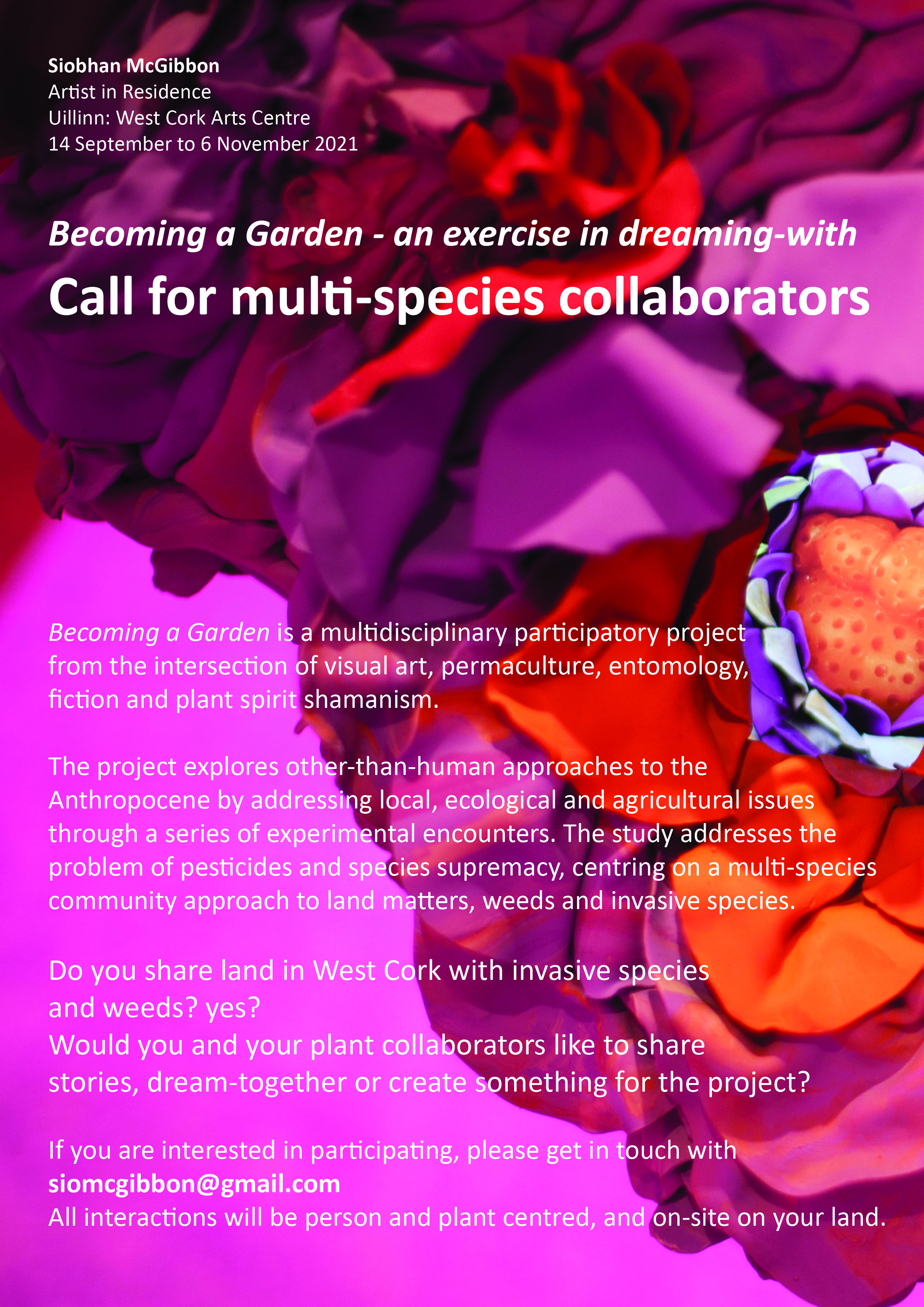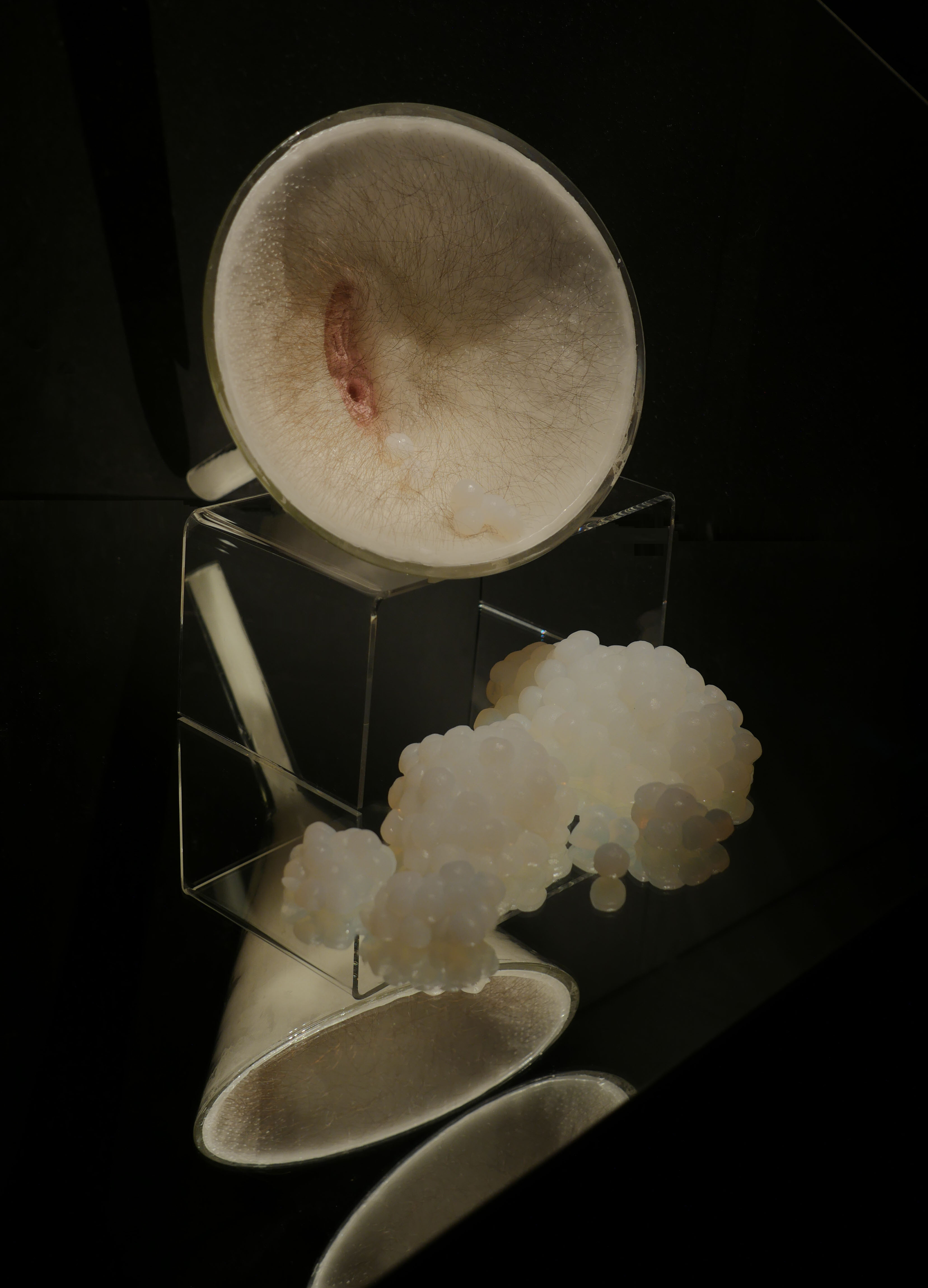Siobhan McGibbon
 Siobhán McGibbon
Siobhán McGibbon
22 July to 31 August 2024
Studio Open to the public on Tuesday and Wednesday
During the residency, Siobhán will research and develop a new enquiry in the world of Xenophon, a critical framework to conduct multispecies research through a speculative, scientific and fictitious lens. This new chapter is a Xenothorpain romance: Love beyond species & the sexual, in 3 Acts. Act 3 will be exhibited in Uillinn in 2026.
The project re-thinks garden relations through the lens of queer desire, which broadens sexuality to include how we inhabit and interact. The work poses that loving beyond protocol can result in more relational choices that disrupt human-centred practices in the garden.
While on residency Siobhan will develop new inquiries in the world of Xenophon, a critical framework to conduct multispecies research through a speculative and scientific fictitious lens. This chapter is a Xenothorpain multispecies romance, told in three acts.
The project is driven by the question of queer multispecies desire, can loving beyond protocol result in more relational choices that disrupt human-centred practices in the garden.
Siobhán will re-think garden relations through the lens of queer multispecies desire, broadening sexuality to include how we inhabit and interact. The idea evolved from my inquiry into pesticides, where the artist became Xenothorpian and merged with Japanese knotweed. As the story unfolds, the artist continues to mutate with the vegetal & develop a romance beyond species and sexual, entering a polyamorous relationship with her partner and the garden.
In the unkempt edges of the garden, Siobhán will explore multispecies desire- how it originates, thrives and evolves. The project positions the overgrown; weeds, hedgerows and meadows as queer sites of desire where unruly cohabitors embrace diversity and fluidity, gender-bending weeds have 'immoral' sex and rhizomes disrupt normative reproduction. Counter to this are the manicured, weeded, overgrazed and cropped sites controlled and depleted by human desire. The project aims to stimulate speculative ethics that elicit new modes of existence beyond species-centric relations.
While on residency Siobhán will work towards a new body of work that will be exhibited in Uillinn in 2026. The artist will develop new approaches to narrative and world immersion through material and sensory storytelling.
Dr. Siobhán McGibbon is an Irish Visual Artist, Researcher & World-builder with a transdisciplinary, art, science and narrative-based practice. Her expression merges sculpture, animation, drawing, permaculture and participatory installations.
McGibbon has collaborated with writers, medical scientists, botanists to build Xenophon, an alternate world populated by Xenothorpians; a fluid species that merge with living & non-living entities to adapt to the Anthropocene. Their hybridisations provide a backdrop from which new stories emerge- a satirical approach to the problem of humans & a critical lens to query multispecies futures. The world continues to unfold and inform her artistic output.
https://www.instagram.com/siobhan_mcgibbon/
Image above: FLIPPING RELATIONS, 2023 Cast of Gunnera manicata, Japanese knotweed paper, Japanese knotweed dye, sculptural silk shibori, blood, urine, hair, montbretia & blackberry dye, watering can, salt, unreal clay. Photograph by Tom Flanagan, Courtesy of Galway Arts Centre Siobhán McGibbon
Siobhán McGibbon
Making oddkin with Japanese knotweed
14 September to 6 November 2021
Making oddkin with Japanese knotweed is an effort to engage with the globalised issues of the Anthropocene, locally, speculatively and co-responsively. To consider how one might better co-habit with others requires meaningful engagement; a quantum leap in imagination is needed. As anthropologist and multi-species scholar, Anna Tsing (2017:07) puts it; 'Somehow, in the midst of ruins, we must maintain enough curiosity to notice the strange and wonderful as well as the terrible and terrifying.' Tsing (2017:07) suggests that in these times of planetary catastrophe, we should begin with the practice of noticing; the humble, the local, the small. In some sense, this project is a response to Tsing’s practice by highlighting how an activity in one back garden can address larger questions concerning environmental futures. As Arundhati Roy (2011:214) puts it;
If there is any hope for the world at all, it does not live in climate change conference rooms or in cities with tall buildings. It lives low down on the ground with its arms around the people, who go to battle every day to protect their forests, their mountains, and their rivers. Because they know that the forests, the mountains, and rivers protect them.
The project reflects on concerns and attitudes towards herbicides, particularly Glyphosate, the most widely used component in pesticides globally. The idea for this inquiry originated when I decided to address the Japanese knotweed (Fallopia japonicain) in the garden. As the invasive species is omnipresent in West Cork, I sought advice from friends, neighbours and people in the community. I quickly became involved in a heated conversation between organic and non-organic farmers about the contentious herbicide round up. I became acutely aware of the dichotomous schools of thought and approaches in my community.
Investigations are focused between three sites in West Cork. The primary site is my rural, coastal and largely unmanicured garden in Schull. The secondary sites are my partner’s family farm in Ballybawn, Ballydehob and the foreshore beach, Schull. The sites are connected through the presence of Japanese knotweed and the notion that the variant found in Ireland is one giant female that produces through cloning. With this in mind, I view each Japanese knotweed site as an extension of the multi-species community of my garden. Each study focuses on biodiversity, approaches to co-habitation, suppression and elimination.
The research connects with environmental and permaculture imaginaries that offer alternative and multi-species visions of the Anthropocene.
The project considers how the unkempt garden, invasive species and all, disrupts the reduction of the garden as a resource for humans. This notion becomes a point of departure to explore, imagine and dream non-hierarchal sites.
Becoming a Garden - an exercise in dreaming-with
Call for multi-species collaborators
Becoming a Garden is a multidisciplinary participatory project from the intersection of visual art, permaculture, entomology, fiction and plant spirit shamanism.
The project explores other-than-human approaches to the Anthropocene by addressing local, ecological and agricultural issues through a series of experimental encounters. The study addresses the problem of pesticides and species supremacy, centring on a multi-species community approach to land matters, weeds and invasive species.
Do you share land in West Cork with invasive species and weeds? yes?
Would you and your plant collaborators like to share stories, dream-together
or create something for the project?
If you are interested in participating, please get in touch with siomcgibbon@gmail.com
All interactions will be person and plant centred, and on-site in your land.
Elemental Schools' Project
Siobhán McGibbon (Ireland)
7 January to 2 March, 2019
For her residency at Uillinn, Siobhán McGibbon is working with a group of 1st to 3rd class children and their teacher Nessa Cotter, from Scoil Naisiúnta an Droma Mhóir, Bantry to create artwork in response to the Elemental exhibition. The children take part in discussions on the artworks, learn about the artists involved and generate their own ideas and artwork. Using collage, drawing, sculpture, animation and more, they are creating artworks that will then become part of the exhibition for its final weeks in the gallery.
A launch of their work, for the children, their parents and the school will take place on Saturday 16 February at 12 noon. Everybody is welcome to come along and celebrate.
Elemental is an exhibition of contemporary sculpture, especially for children, with work by artists Caoimhe Kilfeather and Karl Burke and a creative response space designed and created by Anne Bradley, and curated by Cleo Fagan of Superprojects. Aimed especially at children up to 12 years, Elemental is an exhibition that invites children and people of all ages to encounter contemporary art through touch and movement, as well as sight. Leading artists Caoimhe Kilfeather and Karl Burke have transformed the galleries at Uillinn with their interactive, tactile sculptures and installations that explore scale, texture, space and light.
See the Superprojects website for futher details: Elemental Collaborative Commission
 Siobhan McGibbon
Siobhan McGibbon
The Xenophon Project
March 26 to September 29 2018
Studio open to the public on Thursdays and Fridays.
The Xenophon Project gives a glimpse into a near future that, whilst fictional, is founded on current scientific research. The existence of the Xenothorpean race is a sci-fi-inspired commentary that embodies research undertaken by McGibbon whilst on residency in the Center for Research in Medical Devices (CURAM)(2015-2017) and the Regenerative Medicine Institute (REMEDI)(2016) juxtaposed with concepts of trans-humanism, longevity studies and the mythology of immortality.
The project’s central line of enquiry is, however, the underlying concept of what it means to be human, the inherent boundaries, dilemmas and processes to be encountered in becoming something other than human.
The Xenophon Project is an inter-disciplinary project by visual artist Siobhan McGibbon (Cork) and writer Maeve O’Lynn (Belfast). McGibbon O’Lynn employ sculpture, narrative, animation and technology to explore the interstices between art and science, and the future of the human species. For her residency, Siobhan McGibbon will create a large sculptural installation entitled “UBI TUNC VOX INAUDITAE MELODIAE? ET VOX INAUDITAE LINGUAE?”. This work will explore the projected transcendence from our current state of existence to this enhanced post-human state of being.
Siobhan McGibbon is an Irish visual artist interested in trans disciplinary practice, particularly the intersections between art and medical science. She works conceptually with sculpture, installation, drawing, animation and biomaterials. In 2014 McGibbon was awarded a Limerick Capital of Culture scholarship to undertake a practice based research PhD in the ACADEMY research center at Limerick School of Art and Design, where she is exploring the notion of “The contemporary quest for the fountain of youth” through a series of unusual investigations in the in the sectors of anatomy, medical and biological exploration and centres of scientific enquiry
Image: Future Relic Three: Xenopthor’s Chalice, "The future is already here", Galway City Museum, 2015, Stem cells, Human Hair, wax, found Object. Image courtesy of Tom Flanagan 2015
WCAC acknowledges the financial support of the Arts Council and Cork County Council in making these residencies possible



